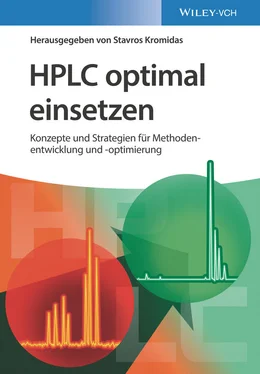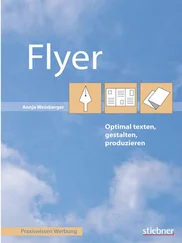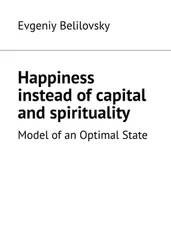1 ...8 9 10 12 13 14 ...23 Tab. 1.2Zusammenfassung der Bedingungen für die HILICxRP-Trennung von PS20.
| Erste DimensionSpalte: HILIC (nackte Kieselsäure); 100 mm × 2,1 mm i. d., 1,8 μm Gradientenelution von 98 bis 0 % B Lösungsmittel A: 10 mM Ammoniumformiat, pH 3 in 50/50 ACN/Wasser Lösungsmittel B: ACN Durchflussrate: 30 μl/min Temperatur: 30 °C Injektionsvolumen: 1 μl Analysezeit: 120 min |
| Zweite DimensionSpalte: RP (C18); 50 mm × 2,1 mm i. d., 1,8 μm Gradientenelution von 20 bis 100 % B Lösungsmittel A: 5 mM Ammoniumformiat, pH 3 in 50/50 MeOH/Wasser Lösungsmittel B: 5 mM Ammoniumformiat, pH 3 in 50/50 Ethylacetat/MeOH Durchflussmenge: 2 ml/min Temperatur: 80 °C Analysezeit (pro Fraktion): 33 s |
| SchnittstelleDoppelschleifen-Design mit 20 μl-Schleifen, im Gleichstrommodus betrieben |
Ich möchte Dr. Gabriel Leme für die Erstellung von Abb. 1.1 danken.
1Venkatramani, C.J., Al-Sayah, M., Li, G., Goel, M., Girotti, J., Zang, L., Wigman, L., Yehl, P. und Chetwyn, N. (2016). Simultaneous achiral-chiral analysis of pharmaceutical compounds using two-dimensional reversed phase liquid chromatography-supercritical fluid chromatography. Talanta 148: 548–555, https://doi.org/10.1016/j.talanta.2015.10.054.
2Hamase, K., Morikawa, A., Ohgusu, T., Lindner, W. und Zaitsu, K. (2007). Comprehensive analysis of branched aliphatic D-amino acids in mammals using an integrated multi-loop two-dimensional column-switching high-performance liquid chromatographic system combining reversed-phase and enantioselective columns. Journal of Chromatography A 1143 (1–2): 105–11, https://doi.org/10.1016/j.chroma.2006.12.078.
3Wang, H., Sun, S., Zhang, Y., Chen, S., Liu, P. und Liu, B. (2015). An off-line high pH reversed-phase fractionation and nano-liquid chromatography – Mass spectrometry method for global proteomic profiling of cell lines. Journal of Chromatography B 974: 90–95, https://doi.org/10.1016/j.jchromb.2014.10.031.
4Erni, F. und Frei, R. (1978a). Two-dimensional column liquid chromatographic technique for resolution of complex mixtures. Journal of Chromatography A 149: 561–569, https://doi.org/10.1016/S0021-9673(00)81011-0.
5Horváth, K., Fairchild, J.N. und Guiochon, G. (2009). Optimization strategies for off-line two-dimensional liquid chromatography. Journal of Chromatography A 1216 (12): 2511–2518, https://doi.org/10.1016/j.chroma.2009.01.064.
6Fairchild, J.N., Horváth, K. und Guiochon, G. (2009). Approaches to comprehensive multidimensional liquid chromatography systems. Journal of Chromatography A 1216(9): 1363–1371, https://doi.org/10.1016/j.chroma.2008.12.073.
7Erni, F. und Frei, R.W. (1978b). Two-dimensional column liquid chromatographic technique for resolution of complex mixtures. Journal of Chromatography A 149: 561–569, https://doi.org/10.1016/S0021-9673(00)81011-0.
8Johnson, E.L., Gloor, R. und Majors, R.E. (1978). Coupled column chromatography employing exclusion and a reversed phase. A potential general approach to sequential analysis. Journal of Chromatography 149: 571–585, https://doi.org/10.1016/S0021-9673(00)81012-2.
9Luo, H., Zhong, W., Yang, J., Zhuang, P., Meng, F., Caldwell, J., Mao, B. und Welch, C.J. (2017). 2D-LC as an online desalting tool allowing peptide identification directly from MS unfriendly HPLC methods. Journal of Pharmaceutical and Biomedical Analysis 137: 139–145, https://doi.org/10.1016/j.jpba.2016.11.012.
10Jayamanne, M., Granelli, I., Tjernberg, A. und Edlund, P.-O. (2010). Development of a two-dimensional liquid chromatography system for isolation of drug metabolites. Journal of Pharmaceutical and Biomedical Analysis 51 (3): 649–657, https://doi.org/10.1016/j.jpba.2009.09.007.
11Groskreutz, S.R., Swenson, M.M., Secor, L.B. und Stoll, D.R. (2012). Selective comprehensive multi-dimensional separation for resolution enhancement in high performance liquid chromatography, Part I – Principles and instrumentation. Journal of Chromatography A 1228: 31–40, https://doi.org/10.1016/j.chroma.2011.06.035.
12Murphy, R.E., Schure, M.R. und Foley, J.P. (1998). Effect of sampling rate on resolution in comprehensive two-dimensional liquid chromatography. Analytical Chemistry 70: 1585–1594, https://doi.org/10.1021/ac971184b.
13Horie, K., Kimura, H., Ikegami, T., Iwatsuka, A., Saad, N., Fiehn, O. und Tanaka, N. (2007). Calculating optimal modulation periods to maximize the peak capacity in two-dimensional HPLC. Analytical Chemistry 79 (10): 3764–3770, https://doi.org/10.1021/ac062002t.
14Davis, J.M., Stoll, D.R. und Carr, P.W. (2008). Effect of first-dimension undersampling on effective peak capacity in comprehensive two-dimensional separations. Analytical Chemistry 80 (2): 461–473, https://doi.org/10.1021/ac071504j.
15Stoll, D.R., Sajulga, R.W., Voigt, B.N., Larson, E.J., Jeong, L.N. und Rutan, S.C. (2017). Simulation of elution profiles in liquid chromatography – II: Investigation of injection volume overload under gradient elution conditions applied to second dimension separations in two-dimensional liquid chromatography. Journal of Chromatography A 1523: 162–172, https://doi.org/10.1016/j.chroma.2017.07.041.
16Pursch, M. und Buckenmaier, S. (2015). Loop-based multiple heart-cutting two-dimensional liquid chromatography for target analysis in complex matrices. Analytical Chemistry 87 (10): 5310–5317, https://doi.org/10.1021/acs.analchem.5b00492.
17Giddings, J.C. (1984). Two-dimensional separations: Concept and promise. Analytical Chemistry 56 (12): 1258A–1270A, https://doi.org/10.1021/ac00276a003.
18Gilar, M., Olivova, P., Daly, A.E. und Gebler, J.C. (2005). Orthogonality of separation in two-dimensional liquid chromatography. Analytical Chemistry 77 (19): 6426–6434, https://doi.org/10.1021/ac050923i.
19Dugo, P., Favoino, O., Luppino, R., Dugo, G. und Mondello, L. (2004). Comprehensive two-dimensional normalphase (adsorption) – Reversed-phase liquid chromatography. Analytical Chemistry 76 (9): 2525–2530, https://doi.org/10.1021/ac0352981.
20Pirok, B.W.J., Gargano, A.F.G. und Schoenmakers, P.J. (2017). Optimizing separations in on-line comprehensive two-dimensional liquid chromatography. Journal of Separation Science 41 (1): 68–98, https://doi.org/10.1002/jssc.201700863.
21Schure, M.R. und Davis, J.M. (2015). Orthogonal separations: Comparison of orthogonality metrics by statistical analysis. Journal of Chromatography A 1414: 60–76, https://doi.org/10.1016/j.chroma.2015.08.029.
22Gilar, M., Fridrich, J., Schure, M.R. und Jaworski, A. (2012). Comparison of orthogonality estimation methods for the two-dimensional separations of peptides. Analytical Chemistry 84 (20): 8722–8732, https://doi.org/10.1021/ac3020214.
23Stoll, D.R., Lhotka, H.R., Harmes, D.C., Madigan, B., Hsiao, J.J. und Staples, G.O. (2019). High resolution two-dimensional liquid chromatography coupled with mass spectrometry for robust and sensitive characterization of therapeutic antibodies at the peptide level. Journal of Chromatography B, November, 121832, https://doi.org/10.1016/j.jchromb.2019.121832.
Читать дальше












